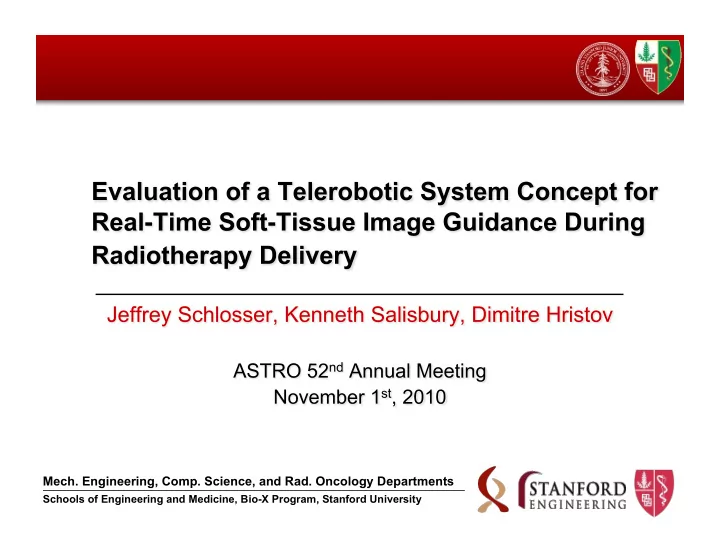

Mech. Engineering, Comp. Science, and Rad. Oncology Departments 1 Schools of Engineering and Medicine, Bio-X Program, Stanford University
Conflict of Interest • Nothing to disclose 2
Imaging During Beam Delivery • Existing solutions are limited: Radiographic x-ray Electromagnetic Real-time marker-less soft-tissue image guidance during beam delivery is an unmet challenge 3
Novel Image Guidance Solution Linear Accelerator Accelerator control console 4D US probe Optical tracker Intervention Patient Treatment Haptic Interface US US-guidance workstation Robot computer Robot Control 3D US image stream US imaging system Probe position data (6 DOF) 4 Telerobotic system enables remote probe control
Telerobotic Imaging Remote Haptic Interface Robot 5
Key Issues • Remote ultrasound imaging during beam delivery ! Robotic manipulator design ! Treatment plan compatibility ! Performance during radiation exposure – Imaging robustness for multiple treatment sites • Image guidance – Temporal calibration and time delay – Spatial calibration and accuracy 6 ! Details to appear in Medical Physics: Schlosser et al. (2010)
Telerobotic Imaging for Multiple Sites Prostate Volunteer Liver Volunteer Kidney Volunteer Pitch Force Time [sec] Time [sec] 100 100 200 200 300 300 400 400 500 500 600 600 7 Image quality remotely maintained over 10 minutes
Image Guidance: Spatial Calibration unknown im T pr pr T tr tr T w F image F probe F tracker F treatment • Goal: find im T pr • Variation of planar fit method from Hartov et. al* 8 *Hartov et al., “Adaptive spatial calibration of a 3D ultrasound system,” Med. Phys., 2010
Image Guidance: Spatial Calibration (1) Collect images of plate (2) Extract points on plane w p = w T tr * tr T pr * pr T im * im p 9 (3) Convert to world frame (4) Optimize planar data fit
Temporal Calibration and System Evaluation: Experimental Method – Image static target in US phantom – Vary probe pitch or pressure – Track target in real-time using NCC – Use transformation chain to register in world frame Guidance Software Optical Robot US probe Tracker Phantom 10
Temporal Calibration and System Evaluation: Experimental Method – Image static target in US phantom – Vary probe pitch or pressure – Track target in real-time using NCC – Use transformation chain to register in world frame Guidance Software Optical Robot US probe Tracker Phantom 11
Temporal Calibration and System Evaluation: Experimental Method – Image static target in US phantom – Vary probe pitch or pressure – Track target in real-time using NCC – Use transformation chain to register in world frame Guidance Software Optical Robot US probe Tracker Phantom 12
Temporal Calibration and System Evaluation: Experimental Method – Image static target in US phantom – Vary probe pitch or pressure – Track target in real-time using NCC – Use transformation chain to register in world frame Guidance Software Optical Robot US probe Tracker Phantom 13
Temporal Calibration and System Evaluation: Experimental Method – Image static target in US phantom – Vary probe pitch or pressure – Track target in real-time using NCC – Use transformation chain to register in world frame Guidance Software Optical Robot US probe Tracker Phantom 14
Temporal Calibration • Novel procedure: – Robot pitches US probe w/ sinusoidal motion – Static target imaged and tracked using NCC – Optical tracker data compared to US pixel data Raw Data Sinusoid Model 92ms 15
Evaluation: Spatial Localization Error World Space Image Space Variable Pitch Pressure Experimental -5 to 5° 0 to 12N Parameters 0.4 Hz Tracking Error 0.4± 0.6± 0.2 mm 0.3mm Max Tracking 0.8 mm 1.3 mm World Space Magnified Error Real-time phantom localization error < 1mm 16
Evaluation: Spatial Localization Error World Space Image Space Variable Pitch Pressure Experimental -5 to 5° 0 to 12N Parameters 0.4 Hz Tracking Error 0.4± 0.6± 0.2 mm 0.3mm Max Tracking 0.8 mm 1.3 mm World Space Magnified Error Real-time phantom localization error < 1mm 17
Evaluation: Spatial Localization Error World Space Image Space Variable Pitch Pressure Experimental -5 to 5° 0 to 12N Parameters 0.4 Hz Tracking Error 0.4± 0.6± 0.2 mm 0.3mm Max Tracking 0.8 mm 1.3 mm World Space Magnified Error Real-time phantom localization error < 1mm 18
Evaluation: Spatial Localization Error World Space Image Space Variable Pitch Pressure Experimental -5 to 5° 0 to 12N Parameters 0.4 Hz Tracking Error 0.4± 0.6± 0.2 mm 0.3mm Max Tracking 0.8 mm 1.3 mm World Space Magnified Error Real-time phantom localization error < 1mm 19
Evaluation: Time Lag • Experimental method: – Similar to time calibration – Robot trajectory (1000Hz) compared to target trajectory in ultrasound sequence Raw Data Sinusoid Model 179ms 20
Real-Time Guidance at 5 Hz and Sub-millimeter Localization Accuracy 21
Conclusions • Remotely-controlled soft-tissue imaging in the treatment vault is feasible for multiple abdominal sites • Sub-millimeter targeting accuracy with 2D imaging indicates feasibility for accurate real-time 3D ultrasound guidance • Telerobotic US guidance system could offer non-invasive localization for IGRT that truly reflects soft-tissue anatomy 22
Questions? Investigator Emails: jschlosser@stanford.edu jks@robotics.stanford.edu dhristov@stanford.edu Mech. Engineering, Comp. Science, and Rad. Oncology Departments 23 Schools of Engineering and Medicine, Bio-X Program, Stanford University
Recommend
More recommend